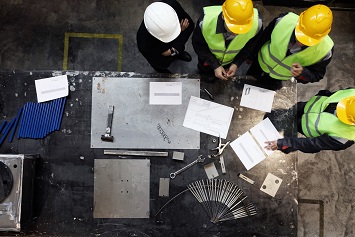Saving money and preventing workplace injuries right from the drawing board are the simple principles behind “Prevention Through Design” (PtD). One common example of PtD is lockout/tagout practices for machinery, but the practice has many applications in the facilities management space. Basically, PtD is the control of workplace hazards by addressing them during the design phase, before a piece of equipment is assembled or an entire facility is built.

ALotOfPeople / iStock / Getty Images Plus / Getty Images
How It Works
When equipment, facilities, and processes are designed in ways that maximize safety, they minimize the possibility of:
- Human error. For example, in building design, continuous stairwells can prove confusing to people trying to escape from the building quickly. Signage notwithstanding, people may think only of getting to the bottom of the stairs quickly and continue on past the ground level into basement levels of the building, where they can become trapped. To prevent this, buildings are often designed so all stairwells terminate on the ground floor, and stairway access to basement levels is completely separate from stairway access to upper levels.
- Deliberate sabotage. Workers often sabotage protective devices when they feel that these devices impair their ability to do their jobs. They remove guards and disable safety interlocks if these things are “getting in their way.” To prevent this kind of tampering, it is important to ensure that safety measures are seamlessly integrated into any equipment in a facility. This makes them less likely to “get in the way” of workers as well as more difficult to bypass than after-market guards and interlocks.
The Business Case for Prevention Through Design
PtD is typically considered a health and safety initiative. The stated purpose is to eliminate occupational hazards and control risks to workers “at the source,” or as early as possible in the life cycle of items or workplaces. Considered in isolation for their impact on worker health and safety, these efforts are cost-effective. But employers that have implemented PtD principles have seen significant improvements in other business metrics, too, and these are of interest to facilities management professionals.
One area where PtD intersects with common facilities business goals is that of green business practices. Both PtD and green business efforts, for example, emphasize reducing hazardous chemical use. The substitution of less hazardous chemicals in industrial processes improves worker health and safety and a business’s green profile.
PtD principles produce many other cost-effective results, including:
- Improved quality. Making the work easier to do reduces the possibility of mistakes, enhancing product quality.
- Improved productivity. A work environment designed for worker health and safety often proves to be an easier place to get things done, enabling employees to accomplish more in the same amount of time.
- Reducing waste. Disposing of waste can be a significant cost for businesses. PtD principles streamline manufacturing processes, often reducing waste generation.
Learn More
NIOSH has prepared nine instructional modules on preventive engineering. While these modules have been around for some time and are designed for use in college engineering courses, facilities managers could also use them to implement prevention through design principles.
